What are the WHS Penalties for Non-Compliance?
The WHS penalties and affects of non-compliance can be far-reaching, from fines and prosecution to staffing and morale issues.
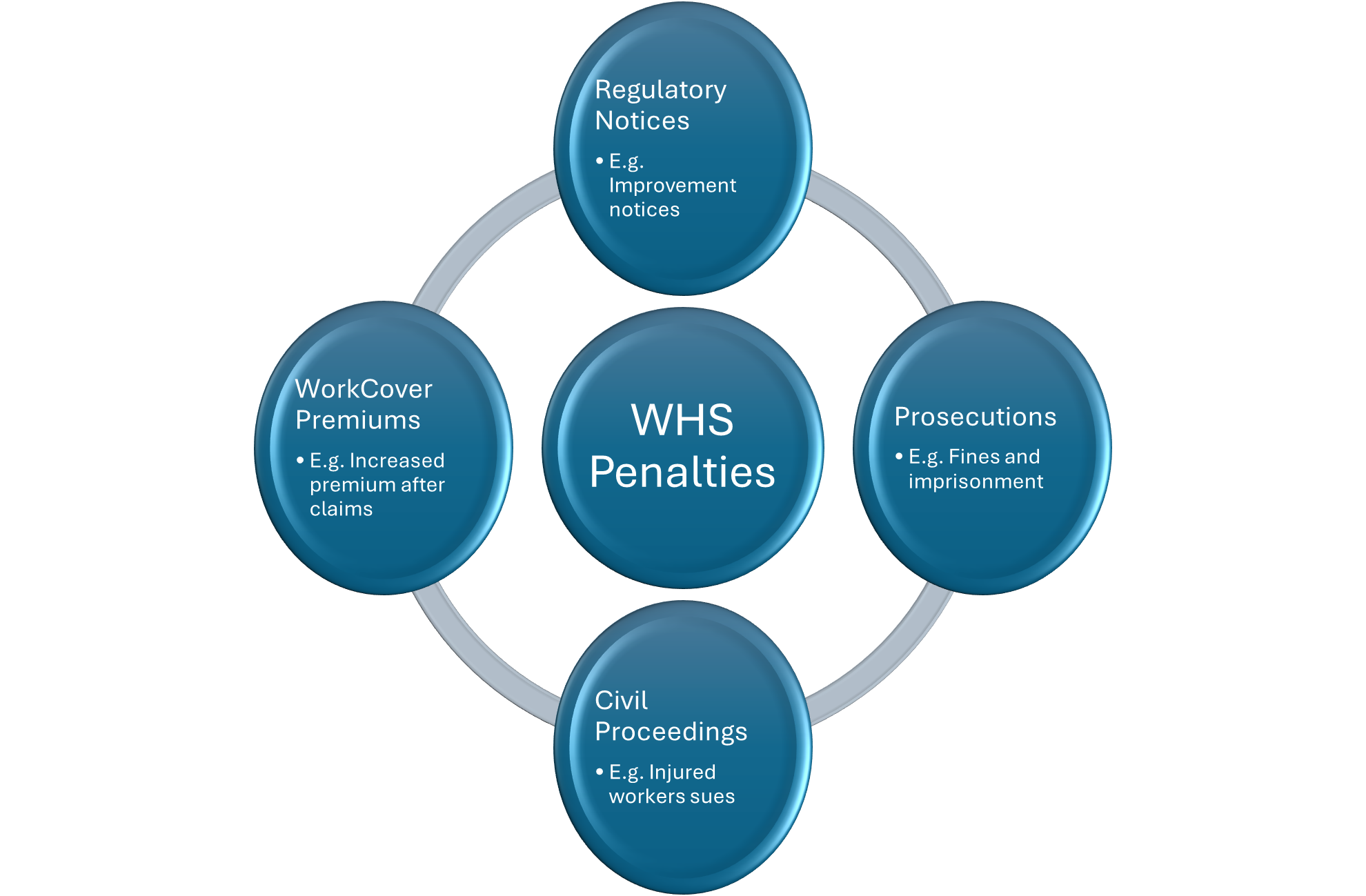 In this article, we will focus primarily on:
In this article, we will focus primarily on:
- Regulatory Notices
- Prosecutions
- Civil Proceedings
Regulatory Notices
Improvement Notice
This document is issued by a government safety inspector and details a suspected contravention of the Act or Regulations. It contains information about who is required to address the issue and when it needs to be addressed.
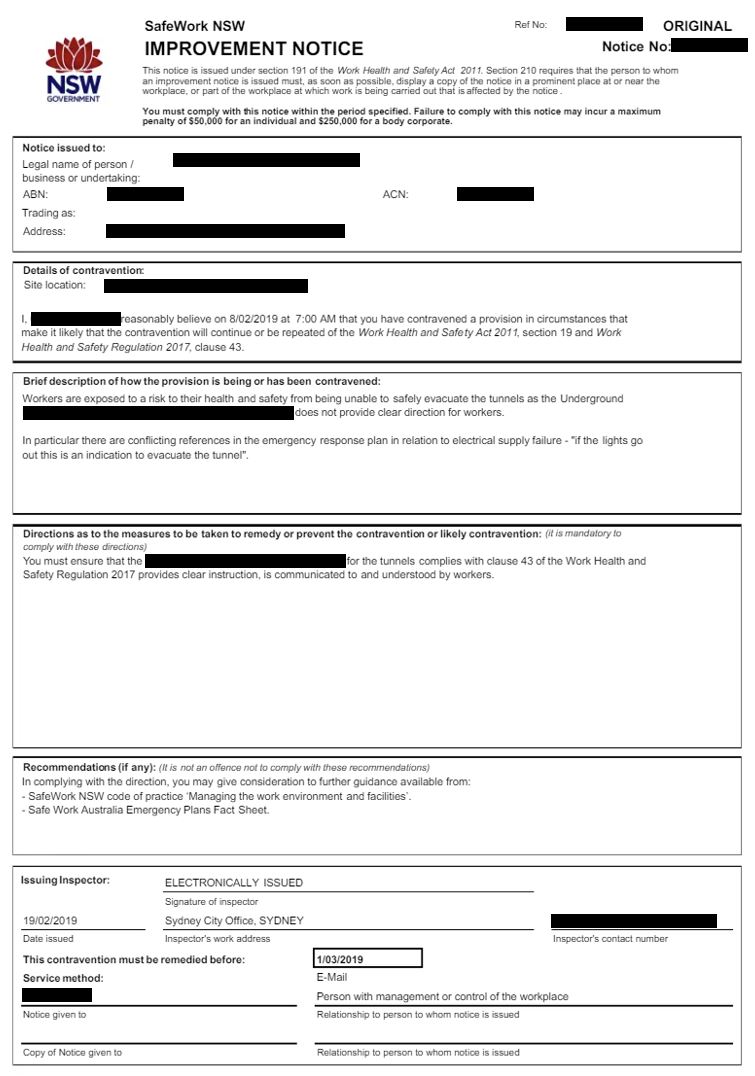
This is the least serious of the WHS penalties, however, the breach must still be rectified.
Prohibition Notice
Like an Improvement Notice, this is issued by a government safety inspector and details a suspected contravention of the Act or Regulations, however, a prohibition notice (as the name implies) prohibits the work activity from being completed until the legislative breach is rectified.
Prosecutions
Category 1 Offence
A person commits a category 1 offence if:
- the person has a health and safety duty; and
- the person, without reasonable excuse, engages in conduct that exposes an individual to whom that duty is owed to a risk of death or serious injury or illness; and
- the person is reckless as to the risk to an individual of death or serious injury or illness.
Category 2 Offence
A person commits a category 2 offence if:
- the person has a health and safety duty; and
- the person fails to comply with that duty; and
- the failure exposes an individual to a risk of death or serious injury or illness.
Category 3 Offence
A person commits a category 3 offence if:
- the person has a health and safety duty; and
- the person fails to comply with that duty.
Industrial Manslaughter
A person commits industrial manslaughter if:
- a worker—
- dies while carrying out work for the business or undertaking; or
- is injured while carrying out work for the business or undertaking and later dies; and
- the person’s conduct causes the death of the worker; and
- the person is negligent about causing the death of the worker by the conduct.
Industrial manslaughter is the most serious of WHS penalties and it carries significant jail time in cases of prosecution.
WHS Penalties for Offences*
| WHS Penalties | Individual | Officer / PCBU | Body Corporate |
| Category 1 | 3,000 penalty units,
5 years imprisonment |
6,000 penalty units,
5 years jail imprisonment |
30,000 penalty units |
| Category 2 | 1,500 penalty units | 3,000 penalty units | 15,000 penalty units |
| Category 3 | 500 penalty units | 1,000 penalty units | 5,000 penalty units |
| Industrial Manslaughter | 20 years imprisonment | NA – see individual | NA |
*Please note we try to keep our website up to date. However, due to constant updates to legislation, its best to check with your local regulator to find exact penalties for non-compliance:
- Safe Work Australia (Model WHS laws) <https://www.safeworkaustralia.gov.au/law-and-regulation/model-whs-laws>
- Comcare (Scheme and legislation – Comcare) <https://www.comcare.gov.au/scheme-legislation>
- QLD (Work health and safety laws) <https://www.worksafe.qld.gov.au/laws-and-compliance/work-health-and-safety-laws>
- NSW (Legislation – SafeWork NSW) <https://www.safework.nsw.gov.au/legal-obligations/legislation>
- ACT (Acts and regulations) <https://www.worksafe.act.gov.au/laws-and-compliance/acts-and-regulations>
- SA (Legislation) <https://www.safework.sa.gov.au/resources/legislation>
- WA (Work health and safety legislation) <https://www.commerce.wa.gov.au/worksafe/work-health-and-safety-legislation>
- NT (The legislative framework – NT WorkSafe) <https://worksafe.nt.gov.au/forms-and-resources/bulletins/the-legislative-framework>
- TAS (Acts and Regulations) <https://worksafe.tas.gov.au/topics/laws-and-compliance/acts-and-regulations>
- VIC (Occupational Health and Safety Act and regulations) <https://www.worksafe.vic.gov.au/occupational-health-and-safety-act-and-regulations>
Examples of WHS Prosecutions
Examples of WHS prosecutions are easily found online (many government websites publish court reports).
 Civil Proceedings
Civil Proceedings
When a worker has been injured or killed and will be contested under tort law i.e. the law that deals with negligence. The injured worker will need to prove that the damage suffered was foreseeable, that it caused a loss to the worker and if the business’s actions were negligent. These payouts can be into the millions of dollars.
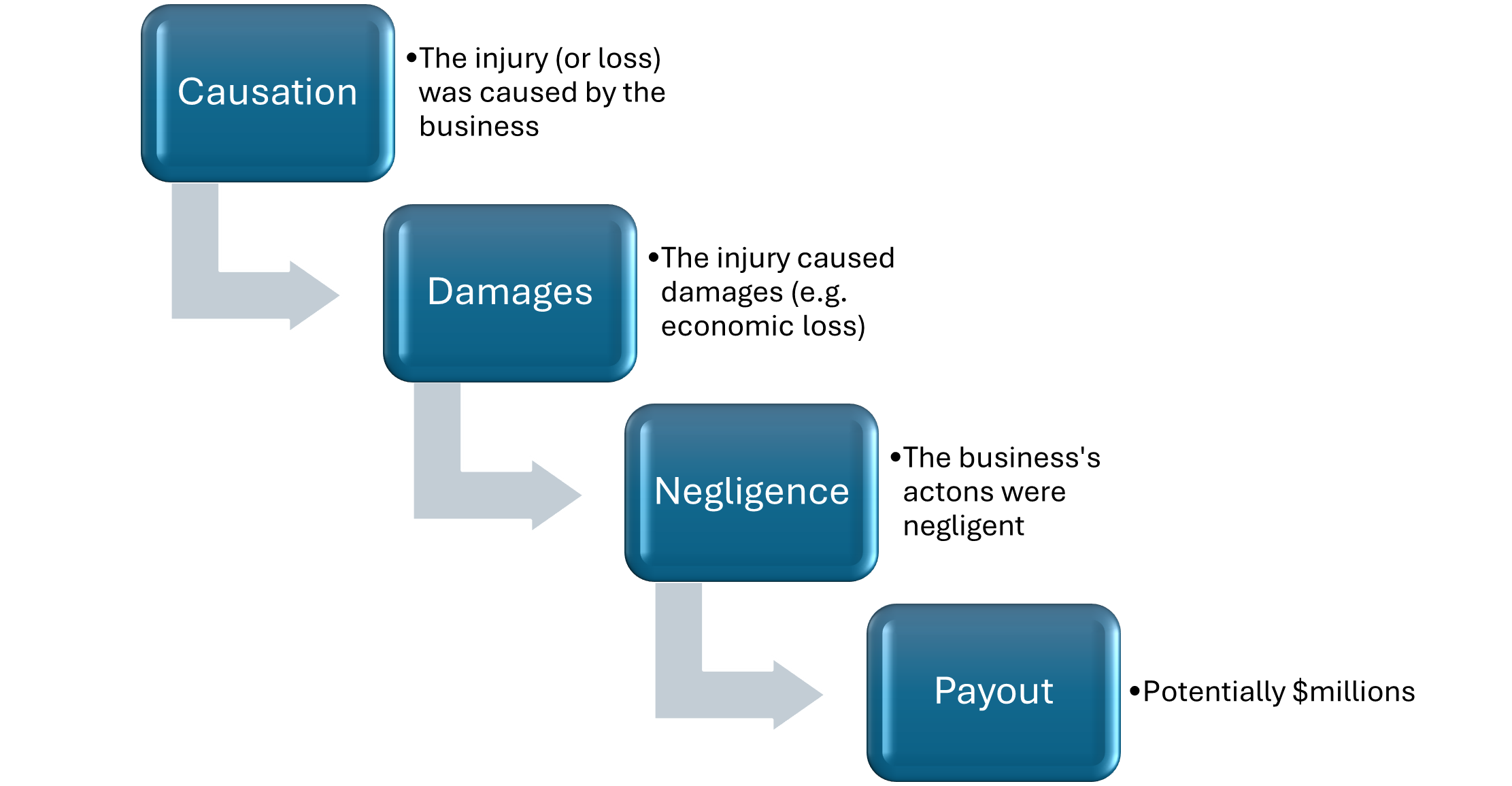
These costs are made up of compensation payments to injured workers as well as legal fees incurred throughout the litigation process.
Examples of Civil Proceedings
We publish examples of civil proceedings on our Case Studies page.
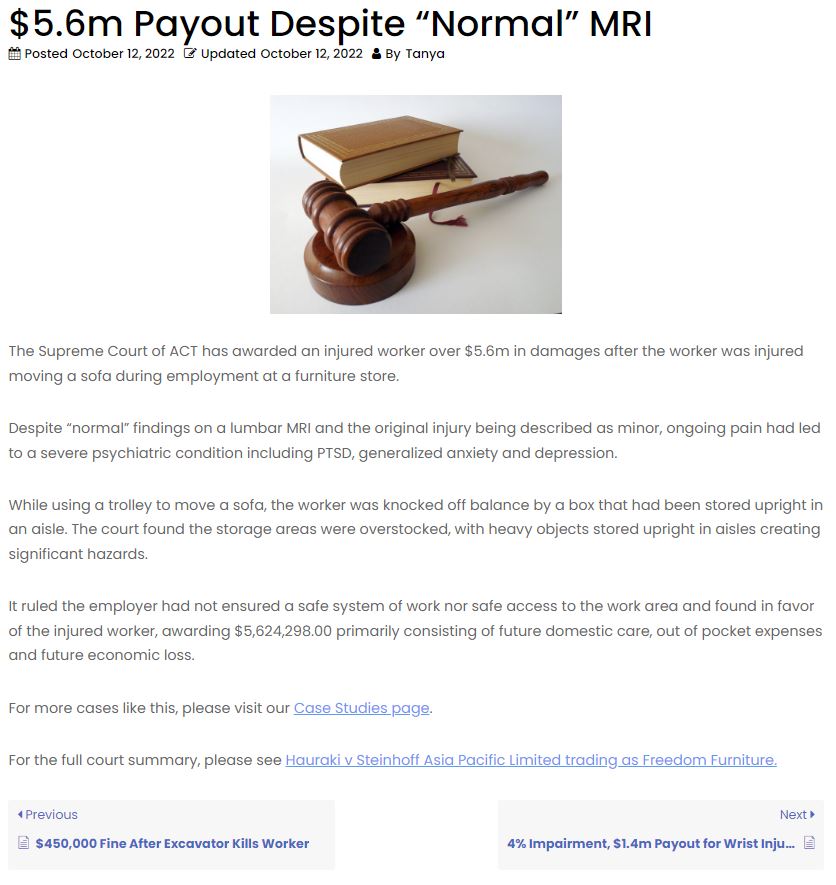
FAQs
What are the categories of WHS offences?
There are three categories: Category 1 involves reckless conduct, Category 2 involves failure to comply with a health and safety duty that exposes someone to risk, and Category 3 involves failure to comply with a health and safety duty.
What are the penalties for a Category 1 offence?
For individuals, the maximum penalty is $600,000 or 5 years imprisonment, or both. For a body corporate, the maximum penalty is $3,000,000.
What are the penalties for a Category 2 offence?
For individuals, the maximum penalty is $300,000. For a body corporate, the maximum penalty is $1,500,000.
What are the penalties for a Category 3 offence?
For individuals, the maximum penalty is $100,000. For a body corporate, the maximum penalty is $500,000.
What is industrial manslaughter under WHS laws?
Industrial manslaughter involves a death caused by a breach of WHS duties. Penalties can include up to 20 years imprisonment for individuals and fines up to $18 million for body corporates.
Can penalties vary between states and territories?
Yes, while the model WHS laws provide a framework, each state and territory may have different maximum penalties.
What other penalties can be imposed?
Courts can impose fines, imprisonment, adverse publicity orders, restoration orders, and require specific WHS projects.
How are WHS penalties enforced?
Penalties are enforced by local workplace health and safety bodies through investigations, fines, and court prosecutions.
Did You Know?
In 1992, Australia witnessed one of its earliest significant WHS prosecutions following the tragic Gretley coal mine disaster in New South Wales. Four miners lost their lives when they accidentally broke into an old, flooded mine shaft. The subsequent investigation revealed serious lapses in safety protocols and record-keeping. The mining company and several individuals were prosecuted, leading to substantial fines and a renewed focus on mining safety regulations.
This case was pivotal in shaping modern WHS laws in Australia, emphasizing the critical importance of accurate historical records and rigorous safety standards to prevent such tragedies.
Articles and Further Reading
- What is a WHSMS (Work Health and Safety Management System)? (Spire Safety) <https://spiresafety.com.au/resources/what-is-a-whsms/>
- Leadership Commitment’s Affect On WHS (Spire Safety) <https://spiresafety.com.au/resources/whs-leadership-commitment/>
- National work health and safety prosecutions data (Safe Work Australia) <https://data.safeworkaustralia.gov.au/about-our-datasets/national-work-health-and-safety-prosecutions-data>

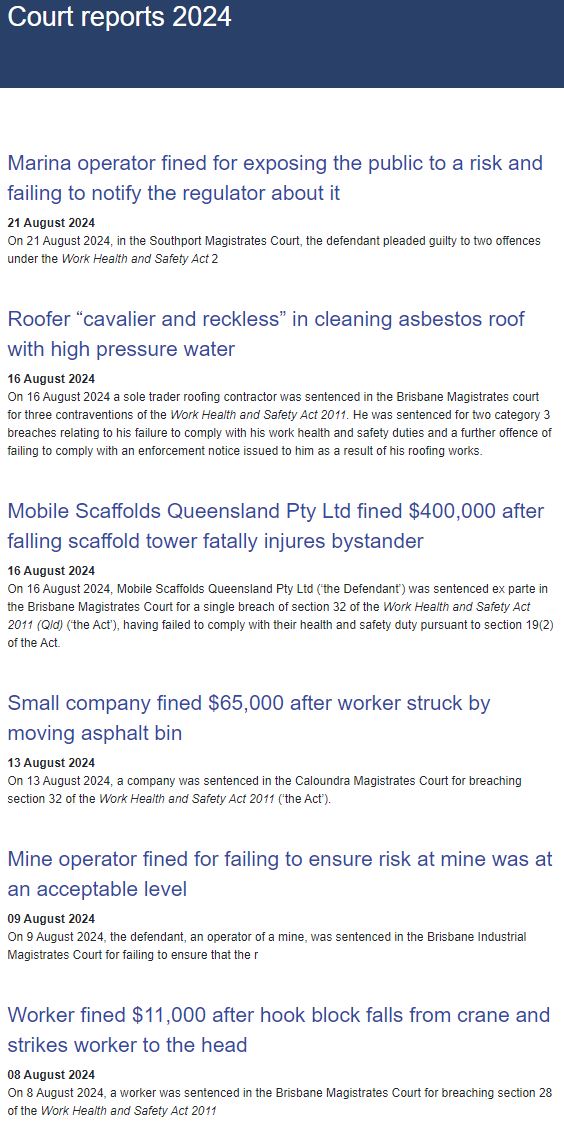 Civil Proceedings
Civil Proceedings